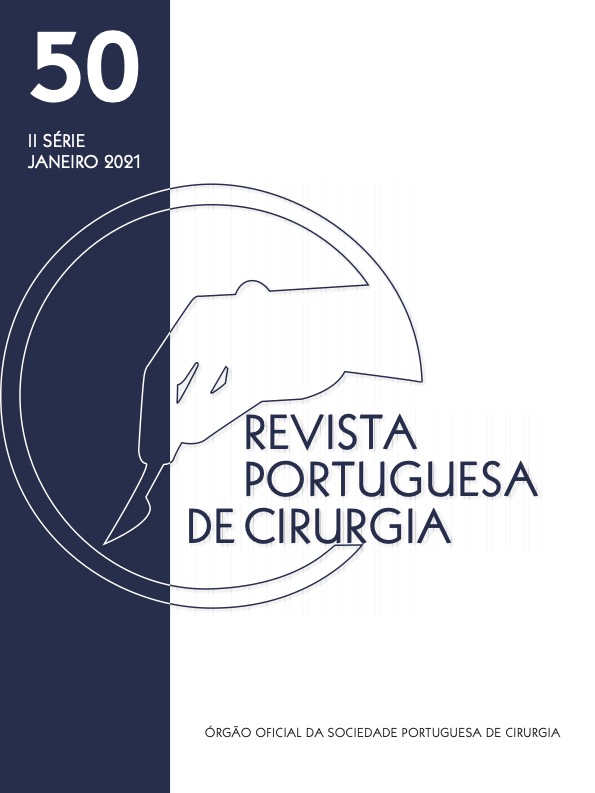GIANT EGIST OF THE TRANSVERSE MESOCOLON: CASE REPORT
DOI:
https://doi.org/10.34635/rpc.709Keywords:
Gastrointestinal Stromal Tumor, Mesocolon, Imatinib, c-kit, SurgeryAbstract
Gastrointestinal stromal tumors are rare tumors of the gastroistestinal tract. Less than 5% of these are not associated to the gastrointestinal tract, being designated EGISTs. EGISTs of the mesocolon are extremely rare, with just a few cases reported in the literature. We present the case of an 82-year old female presenting with nausea and vomiting for a month, having had an ultra-sound(US) and CT which showed “large tumoral formation, mainly cystic, with significant contrast uptake in the solid component, measuring 16,6x11,2 cm, apparently independent from the tail of the pancreas, in the likely dependence of the gastric wall”. Endoscopic US and FNA were perfomed but the result was inconclusive. The patient underwent exploratory laparotomy with atypical gastrectomy, excision of the anterior layer of the transverse mesocolon and omentectomy en-bloc. Histopathology report revealed ephitelioid type malignant EGIST. pT4N0. By patient will no adjuvant therapy was performed. Although rare, GISTs are the most common mesenchymal tumors of the GI tract, nevertheless EGISTs of the mesocolon are extremely rare. Contrarily to what happens with GISTs, the pathogenesis, incidence and prognosis are not fully established for EGIST since there are few cases described. We present a brief review on the diagnosis and therapeutic approach to these cases.
Downloads
References
2 Xue D, Chen H, Chen Y. Giant Extragastrointestinal Stomal Tumor in the Transverse Mesocolon Concomitant With Gasctric Cancer in and elderly patient: Case Report. Oncology Letters 2013; 5: 627-630.
3- ESMO/ European Sarcoma Network Working Group. Gastrointestinal Stromal Tumours: ESMO Clinical Practice GUidelines for Diagnosis, treatment and follow-up. Annals of Oncology 2014; 25, supplement 3.
4 TeraT. Primary Extragastrointestinal Stromal Tumor of the Transverse Mesocolon Without e-ki Mutations but With PDGFR Mutations. Medical Oncology 2009; 26: 233-237.
5 Paparelli C , et al. Giant GIST of the Mesocolon: Report of a Case. Minerva Chir 2006; 61: 537-540.
6 Mazur MT, et al. Gastric Stomal Tumors. Reappraisal of Histogenesis. American Journal Surgical Patolhogy 1983; 7(6): 507-519.
7 Sousa D, et al. EGIST: a Rare Tumor. Jounal of Gastrointest Cancer 2016 doi 10.1007/s12029-016-9856-y.
8 Dimofte MG, et aal. EGIST of a greater omentum – case study and review of literature. Romanian Journal of Morfhology & Embryology 2016; 57(1): 253-258.
9 Goukassian ID, et al. Secondary recurrent multiple EGIST of the mesentary: A case report and review of the literature. International Journal of Surgery Case Reports 2012; 3: 463-466.
10 Demetri GD, et al. NCCN Task Force Report: Update on the Management of Patients with Gastrointestinal Stromal Tumors. Journal of the Nacional Comprehensive Cancer Network 2010; Volume 8 Supplement 2.
11 Reith JD, et al. Extragastrointestinal (soft tissue) stromal tumors: an analysis of 48 cases with emphasis on histologic predictors of outcome. Modern Pathology 2000; 13(5): 577.
12 Casali PGG, et al. Time to definitive failure to the first tyrosine Kinase inhibitor in localized gastrointestinal stromal tumors (GIST) treated with imatinib as an adjuvant. Annals of Oncology 2017: 28 supplement: 605-649
13 Zhao R, et al. Adjuvant Imatiniab for patients with high-risk gastrointestinal stromal tumors: a retrospctive cohort study. Nature, Scientifc Reports 2017 7: 16834 | DOI:10.1038/s41598-017-17266-5
Downloads
Published
Issue
Section
License
Para permitir ao editor a disseminação do trabalho do(s) autor(es) na sua máxima extensão, o(s) autor(es) deverá(ão) assinar uma Declaração de Cedência dos Direitos de Propriedade (Copyright). O acordo de transferência, (Transfer Agreement), transfere a propriedade do artigo do(s) autor(es) para a Sociedade Portuguesa de Cirurgia.
Se o artigo contiver extractos (incluindo ilustrações) de, ou for baseado no todo ou em parte em outros trabalhos com copyright (incluindo, para evitar dúvidas, material de fontes online ou de intranet), o(s) autor(es) tem(êm) de obter, dos proprietários dos respectivos copyrights, autorização escrita para reprodução desses extractos do(s) artigo(s) em todos os territórios e edições e em todos os meios de expressão e línguas. Todas os formulários de autorização devem ser fornecidos aos editores quando da entrega do artigo.



